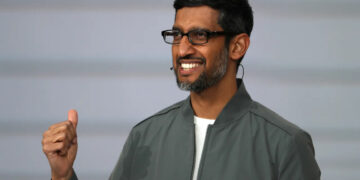On 17 March 2021, The Indo-US Science and Technology Forum brought in a new approach in AI by launching the US India Artificial Intelligence Initiative.
India’s relationship with the US has brought in the most valuable consumer data in the consumer market. For technological organizations, it’s the best thing since sliced bread.
A notable comment by Prof Ashutosh Sharma, the Secretary of the Department of Science and Technology highlighting the glorious history of Indo-US relationships in Science and Technology in the past have been remarkably beneficial for both countries.
This new venture seems to bring a plethora of opportunities for Indo-US relationships. According to the geopolitics experts in a conversation with the Analytics India Magazine acknowledged and anticipated what will India profit from the partnership.
Alliances with the Nations
Technological advancement would further foster the relationships of the nations. Also, AI has a prominent place in modern geopolitics. The new Indo-US AI initiative strengthens the collaboration in defense and healthcare in India.
In the same line, India has made advances in the BrahMos cruise missile with Russia. India’s venturing over 6G with Finland is an epitome of the government’s success in geopolitics.
Though India is in the early stage with AI, the assistance and collaboration with the US in science and technology would boost the field of AI. Currently, India doesn’t have a firm stand on what norms would govern AI.
The statement by Arindrajit Basu, Program Manager at the Center of Internet & Society says that it is difficult to predict because of unclear priorities of India.
He further added, the gigantic inclination of Indo-US collaboration in the field of Science and Technology. With the bi-lateral and multilateral initiatives and introducing techs like USIAI or GPAI, the Indo-US cooperation is far much clearer. Along with the Quad, for the general security directing on the technology.
Indo-US Win-Win
It is going to be a dual benefit deal and progress for both nations. India provides the US with massive consumer markets for the data. In turn, India finds solutions to various development problems ranging from healthcare to providing banking to the huge population and advancing the Indian military with the help of US algorithms.
The great aspect of this deal is India bringing on the table the Engineers and Computer Scientists which is what these organizations require. Moreover, the new geopolitics realities have made this partnership possible. Yet, there is an alarming concern for this collaboration.
It certainly directs towards China’s development in the field of AI. Basu mentioned the significance of the democratic governance model in emerging technology which is put forward by both India and the US. Despite the change in power of the US government, the stand on certain issues like distrust towards China and its technology remains intact.
The stern aspiration to maintain the supply chains governed with rules, standards, and norms of the democratic world. India and the US want to grasp AI along with new technologies for nurturing relationships with other nations and to have a geopolitical edge.
This situation is the perfect paradigm of a win-win situation. Taking into account US requirements, it needs allies like India to have a global stand against China. In the case of India, the US provides the much-needed technology and support to India to have a global presence.
The consensus is that geopolitics is governed by technological factors, both nations want to develop AI. The striking feature of this cooperation is that India is shifting from its non-aligned position and moving towards the “technology orbit” of the West because of the next geopolitics.
Anticipating Progression
The forthcoming technology in the form of AI will redefine the structure of relationships between the nations. India should grasp this opportunity to use its capacity to broaden its aspects in the field of Artificial Intelligence.
Technological advancement is what would cohere the nations and look forward as the model of binding the nations. According to the statement by Prakash, India might face problems in Southeast Asia because of the increasing competition among the world superpowers.
Another approach is formulating how India can even use AI with the help of the US to understand how it works. For India, it would be an opportunity to create AI- corridors with its algorithms because of the knowledge it has empowered in AI. While creating a community between Southeast Asia, India can establish its new geopolitical supremacy.
It’s viable to make it possible through QUAD or even by Five Eyes.
A matter of concern required to address is regarding the safeguards for the protection of Indian citizens from the exploitative data practices of the US. It could not only result from the US but other world’s major economies.
Basu added a diplomatic statement concerning how the interests of the Indian citizens need protection and simultaneously avoiding the regulatory scuffle. The major objective behind this was to keep proactive regulation. It actively protects data privacy.
Also curbs inequitable mergers, law competition, and anti-competitive practices. The initial step starts from ensuring equitable taxation of these companies.
At the same time, there is a possible threat of losing the collaboration for investing in these companies owing to the regulatory processes. If processes undetermined, extreme, and counterproductive for these companies.
Basu says that the final design for this cooperation relies on the objective that the stakeholders ensure the regulatory processes are provided in a free and fairway. This corroborates the protection of the citizen’s rights and simultaneously keeps into consideration that businesses should not suffer.













